 Plant Biology
Plant Biology
The flesh-eating Venus flytrap plant generates its own magnetic fields
Each leaf of the carnivorous Venus flytrap plant ends in a jaw-like trap which imprisons unsuspecting insect prey. The traps are electrically active and produce electrical signals that trigger the trap to close around the insect. We discovered that this electrical signal also produces a measurable magnetic field.

In recent decades, more and more techniques from physics have been applied to biological systems, often with far-reaching consequences. For example, noninvasive techniques like magnetic resonance imaging (MRI) are now commonly used to study or diagnose the human brain and body. The successful transfer of physics-based technologies to the animal kingdom has led some researchers to investigate possible parallel applications in the plant kingdom. Our research in particular focuses on the measurement of tiny magnetic fields using sensitive devices called atomic magnetometers.
Just as electrical currents in Earth’s core produce the geomagnetic field, we know that electrical signals which move through the human and animal nervous system produce measurable magnetic fields. This is consistent with the law of electromagnetism which states that electric currents generate magnetic fields. In our work, we asked the question, does intrinsic electrical signaling in multicellular plant systems also generate magnetic fields large enough to be detected? We tackled this question with our interdisciplinary team of researchers throughout Germany.
Most plants have weak and slow types of electrical signaling. In contrast, the Venus flytrap (Dionaea muscipula) is a carnivorous plant which produces rapid “animal-like” electrical signals to trigger its jaw-like trap to snap shut. The flytrap was therefore a good candidate for us to study with existing magnetometry technology already used to detect magnetic fields from animals.
In order to search for possible magnetic activity in the Venus flytrap, we first needed to understand the underlying biology of the system. The flytrap, native to the coastal Carolinas in the United States, is a wonder of the plant world. Its traps can be stimulated in a number of ways—including by touching its trigger hairs (as a prey insect would do), applying salt, heating, or cooling. All these various energy inputs increase calcium levels inside the cells of the trap by opening ion channels in the cell membranes, leading to an electrical signal that travels throughout the entire trap in a fraction of a second. The firing of two consecutive electrical signals within less than 30 seconds prompts the trap to snap shut. For our magnetic-field experiments, it was most convenient to stimulate the traps using heat, because the magnetic sensors we used operate at an elevated surface temperature of 41°C. This temperature was sufficient to induce electrical signals in all the traps we tested, which we measured using standard surface electrodes.
To measure the plants’ magnetic fields, we used sensitive atomic magnetometers. These devices are normally used to map human brain activity, by recording magnetic fields produced by electric currents in the brain. Atomic magnetometers employ a glass cell containing a gas of atoms, whose electron spins are sensitive to changes in the local magnetic-field environment. Since magnetic background noise can disturb magnetometer operation, we measured the flytraps in a magnetically shielded room at Germany’s national metrology institute in Berlin. As each trap was stimulated, we recorded its electric and magnetic activity simultaneously. We found that the electrical signals fired by the Venus flytraps, which are a thousand times weaker than the voltage from a wall outlet, were correlated with magnetic fields of up to half a picotesla (millions of times weaker than Earth’s magnetic field), when measured at a radial distance of 7 mm from the trap surface. This was an exciting result—at the outset of our experiments, one possible outcome was that we would not see any magnetic signal at all, as magnetic fields from electric currents in opposite directions can cancel each other out. Unlike in animal neurons where the electrical signal only travels in one direction, the signal in the Venus flytrap tissue must travel in 2D from its starting point to reach all areas of the trap.
This is the first time that biomagnetic signals from Venus flytraps have been detected, and the first measurement of plant biomagnetism using atomic magnetometers. The major competing technology for sensitive biomagnetic measurements, known as SQUID (superconducting-quantum-interference-device) magnetometers, faces the limitation that the sensors must be cryogenically cooled using bulky cryostats. Atomic magnetometers, by contrast, operate at ambient temperatures and can be portable and miniaturized, making them ideal for plant applications. Currently, monitoring of plant electrical activity is very much rooted in localized electrode-based techniques, whereby electrodes are inserted into the plant sample, rather than in measurement of the magnetic field. In the future, we hope to demonstrate magnetic measurements of other plants, including agricultural species, since we believe that magnetometry is a promising tool for noninvasive monitoring of plant physiology, stress, and disease.
Original Article:
Fabricant, A., Iwata, G. Z., Scherzer, S., Bougas, L., Rolfs, K., Jodko-Władzińska, A., Voigt, J., Hedrich, R., & Budker, D. (2021). Action potentials induce biomagnetic fields in carnivorous Venus flytrap plants. Scientific Reports, 11(1), 1438. https://doi.org/10.1038/s41598-021-81114-wNext read: Discovery of the first radiation belt beyond the Solar System by Juan Bautista Climent Oliver
Edited by:
Zoé Valbret , Senior Scientific Editor
We thought you might like
More from Plant Biology
Unravelling the Secrets of Pine Roots: A Tale of Nutrition and Adaptation
Oct 20, 2023 in Plant Biology | 3.5 min read by Rafael Cañas , Francisco OrtigosaStressful memories help plants resist caterpillars
Oct 2, 2023 in Plant Biology | 3.5 min read by Samuel Wilkinson , Adam Hannan Parker , Jurriaan TonDecoding the genome of a jackfruit that grows all year round
Sep 6, 2023 in Plant Biology | 3.5 min read by Tofazzal IslamLife after logging: the tale of recovering tropical forests
Aug 21, 2023 in Plant Biology | 3.5 min read by Maria Mills , Terhi RiuttaEditor's picks
Trending now
Popular topics


